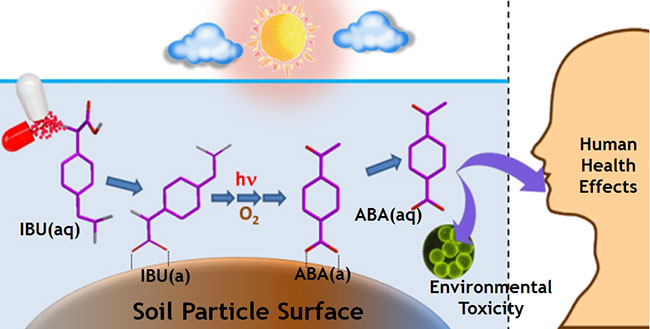Fate, Transportation and Toxicological Effects of Pharmaceuticals and Personal Care Products (PPCPs)
Growing medical and personal needs of the human population has escalated the discharge of pharmaceuticals and personal care products (PPCPs) to the environment. This has raised major concerns related to environmental and human health. PPCPs have been reported in human breast milk, blood, and urine at concentrations high enough to cause physiological and genetic changes. However, only limited research has been done to determine the occurrence and human health risks of PPCPs in the environment. Moreover, we poorly understand the environmental degradation, transformation and fate of PPCPs, and the toxicological impacts of these nonextractable secondary residues. Our overall goal is to determine the environmental degradation of PPCPs, and evaluate the long-term health risks of PPCPs and their degradation products to humans and ecosystem. Our objective of this work is to quantify chemical breakdown of PPCPs in the presence of suspended soil particles in open waters, and determine the toxicity of their degradation products. Our rationale is that environmental PPCPs are in constant contact with suspended soil particles that provide a highly reactive surface where diverse chemistry occurs.
In our lab, we investigate abiotic degradation pathways of selected PPCPs, including ibuprofen, clofibric acid, bisphenol A, amoxicillin, and diclofenac acid, followed by toxicological assays to evaluate acute health effects of degraded PPCPs. Some of this work on ibuprofen is already published in Water Research. In the past year, we integrated more human health related studies. Here, we have established a strong collaboration with Dr. Rodolfo Tello-Aburtho (Chemistry, NMT) to synthesize the identified degradation products of selected PPCPs. To evaluate human health effects, we use several model systems including gut microbiota species; Lactobacillus acidophilus, Enterococcus faecalis, and Escherichia coli, and two human cell lines; HEK293K and HepG2. In this work, environmental impact is also assessed using a bioluminescence bacteria, Vibrio fisheri. Overall, our results highlight that some of the degradation products of ibuprofen can be more than or at least as toxic as the parent compound to humans as well as environmental species. These bioassays are conducted in collaboration with Dr. Praveen Patidar, (Department of Chemistry) and Dr. Snezna Rogelj (Department of Biology).

ADMINISTRATIVE ASSISTANT
GAYAN R. RUBASINGHEGE
Associate Professor of Chemistry
New Mexico Institute of Mining and Technology
Department of Chemistry
801 Leroy Place
Socorro, NM 87801
Bethany Jessen
New Mexico Institute of Mining and Technology
Department of Chemistry
801 Leroy Place
Socorro, NM 87801
Phone: 575-835-5129
Fax: 575-835-5215
Phone: 575-835-5263
Fax: 575-835-5364
Copyright © 2018 The Environmental Chemistry Research Research Group. All rights reserved.